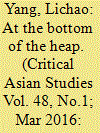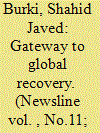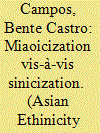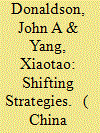| Srl | Item |
| 1 |
ID:
143667


|
|
|
|
|
| Summary/Abstract |
This article explores the health, disease and socioeconomic circumstances of garbage collectors in Guiyang, southwestern China. It aims to contribute to medical anthropology and understandings of Chinese society by examining garbage collectors’ understandings of waste picking, pollution and the health risks and diseases associated with their struggles for survival at the “bottom of the heap” of peri-urban society in contemporary China. Drawing on one month of ethnographic fieldwork, it provides new insights into the oft-neglected subjectivity of individuals struggling for survival at the margins of Chinese society, and how this subjectivity is shaped by their structural position as well as by their own agency in making sense and making the best of their lives.
|
|
|
|
|
|
|
|
|
|
|
|
|
|
|
|
| 2 |
ID:
156221


|
|
|
| 3 |
ID:
113897


|
|
|
|
|
| Publication |
2011.
|
| Summary/Abstract |
Studies of internal migration in contemporary China frequently focus on the movement of rural people to urban centers, while studies of Chinese tourism concentrate on the mobility of urban travelers. These approaches to mobility coincide neatly with established understandings of modernity, despite the fact that the Chinese government has tried to promote certain forms of rural modernization without mobilization-hence the national slogan "leave the fields without leaving the countryside." This article complicates the relationship between modernity and mobility in China by examining mobility from the perspective of returned migrants in rural, ethnic minority tourism villages. Through the analysis of five migrants' stories of travel, I explore the ordering of mobility, or how differing types of mobility come to be re-signified in times of immense social change and the consequences of these symbolic shifts on local understandings of ethnic identity and rural livelihoods. My argument builds on analytical frameworks of mobility in post-reform China by examining how mobility itself has been ordered in ways that reveal particular desire, inequalities, and power relations. By exploring how mobility both orders social relationships and how different forms of mobility, such as tourism or migration, come to be ordered in relation to each other, I draw attention to how mobility, and by extension immobility, generates the conditions of possibility for tourism village residents to make sense of the potential and paradoxes of rural, ethnic tourism development in contemporary China.
|
|
|
|
|
|
|
|
|
|
|
|
|
|
|
|
| 4 |
ID:
141161


|
|
|
|
|
| Summary/Abstract |
This article studies the Miao classification as an example to examine the minzu shibie project initiated by the Chinese Communist Party after 1949. The Miao classification that originates with the minzu shibie project can be defined as a process of miaoicization; however, it is not a unified Miao group (as projected by the classification team) that has emerged but rather one dominant Miao subgroup that defines the official Miao category in contemporary China. At the moment the most dominant Miao subgroup is the Hmu group in Southeast Guizhou. The overemphasis of Hmu sub-culture to represent all the Miao of China is related to the fact that over the last decades many important leaders in Guizhou have been Hmu. While all Hmu are sinicized to a certain extent, it seems that the Hmu at the bottom of the socioeconomic scale are most likely to be sinicized and to amalgamate with the Han majority.
|
|
|
|
|
|
|
|
|
|
|
|
|
|
|
|
| 5 |
ID:
184723


|
|
|
|
|
| Summary/Abstract |
Why do provincial governments change policy, even when those policies have proven successful? This paper explores a debate regarding the determinants of provincial policy choice and the degree of discretion provinces are permitted in this area. It does so by scrutinizing the shift in Guizhou's development policy from a poverty reduction orientation to a wholehearted pursuit of economic growth, urbanization and industrialization. In contrast to those who argue that central experience, prospects for promotion or local conditions are key factors explaining policy choice, the paper concludes that Guizhou's shift in policy had more to do with the backgrounds and experiences of top provincial leaders. The result has implications for our understanding of central–local relations and local government decision making.
|
|
|
|
|
|
|
|
|
|
|
|
|
|
|
|